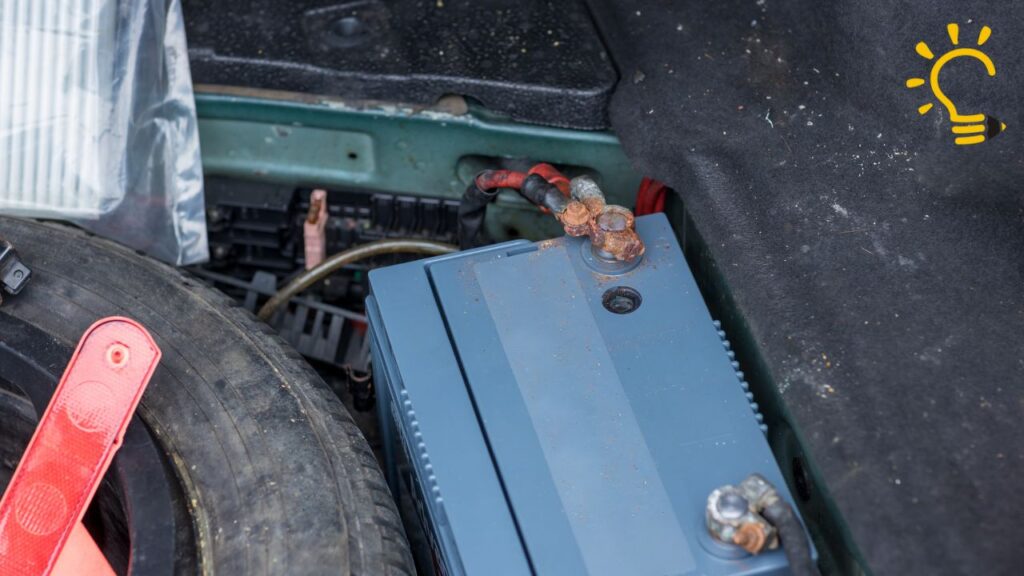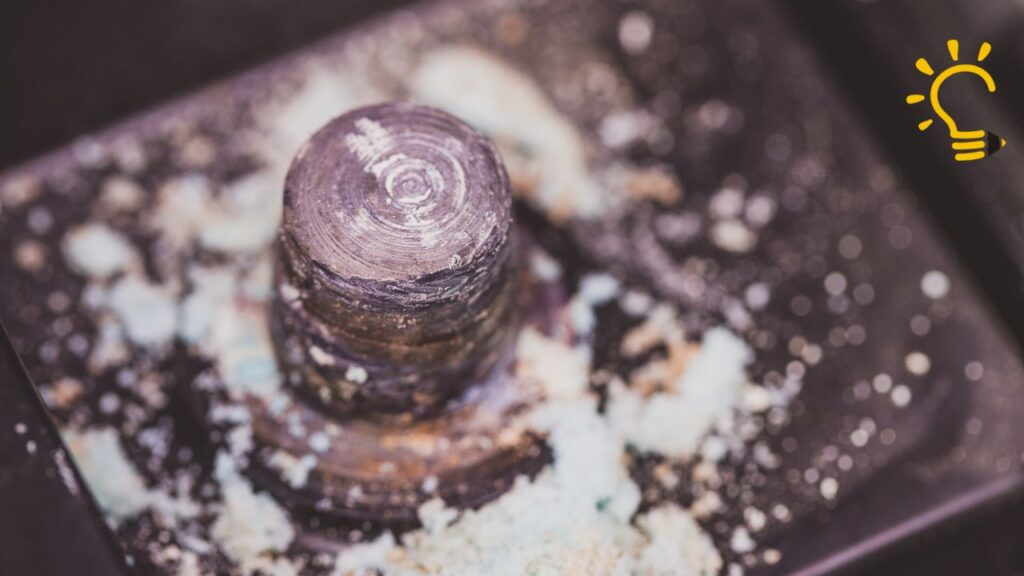Did you know that learning how to clean battery corrosion properly can significantly extend the life of your devices? Battery corrosion is a common issue that impacts everything from small electronics to large industrial batteries, potentially causing reduced efficiency, starting difficulties, and even safety hazards.
We’ve discovered that cleaning battery terminals takes only about 10 minutes but can prevent serious damage to your devices. If you’re wondering how to remove battery corrosion or how to clean battery terminals effectively, you’re in the right place. Many people ask us, “how do you clean battery corrosion safely?” particularly when dealing with potentially irritating substances like potassium hydroxide from leaking alkaline batteries. Additionally, learning how to get rid of battery corrosion and how to clean battery acid requires some simple but important safety precautions.
In this guide, we’ll share our proven step-by-step process using readily available household items like baking soda and water. We recommend inspecting your battery terminals every six months, as regular maintenance prevents excessive buildup that can hinder performance. Let’s dive into this simple but essential maintenance task that actually works!
Recognizing Battery Corrosion and Its Risks
Battery corrosion isn’t just an unsightly nuisance – it’s a warning sign that requires your attention. Spotting this problem early can save you from frustrating device failures and potentially dangerous situations. Let me walk you through what to look for and why it matters.
Signs of corrosion on terminals
Corrosion appears as a crusty, powdery substance that accumulates around battery connections. You’ll typically notice:
- Color variations: Look for white, blue, or green deposits on or around the battery terminals and cables. This flaky, ashy residue resembles crusty mold on bread.
- Unusual odor: Corroded batteries often emit a distinctive rotten egg-like smell, which is a telltale sign of chemical reactions occurring.
- Visible damage: In advanced cases, you might see frayed cables, a bloated battery case, or signs of leakage around the affected area.
Remember that this powdery substance isn’t just dirt – it’s a chemical reaction between salt, moisture, air, and hydrogen gas that forms lead sulfide crystals. These substances are caustic, so avoid direct contact which can cause permanent damage to your skin or eyes.

Why corrosion affects performance
Corrosion substantially impacts how your devices function through several mechanisms:
Firstly, these deposits act as insulators, restricting the electrical current needed to power your devices. Since they prevent proper contact between cables and posts, even jumpstarting might prove impossible until you clean the corrosion.
Moreover, corrosion increases electrical resistance, hindering current flow and causing a cascade of problems. In vehicles, this manifests as slow cranking, dim headlights, or clicking sounds when you turn the key. For smaller electronics, you’ll notice decreased power, weak performance, or complete failure to function.
Furthermore, corroded terminals can create pathways for current to leak even when devices aren’t in use, leading to premature battery discharge. This explains why you might find your device mysteriously drained despite minimal usage.
When to act quickly
Certain situations demand immediate attention to prevent serious damage:
Prompt action is essential if you notice electrical issues like slow cranking, dim lights, or difficulty starting your vehicle. These symptoms indicate the corrosion is already affecting performance.
Additionally, if you see bluish precipitate (copper sulfate) forming around copper terminals, address it immediately – this substance conducts electricity poorly and will rapidly worsen starting problems.
Generally, corroded terminals can cause electrical shorts, potentially damaging electronic components and even causing fires in vehicles. In extreme cases, severe corrosion leads to gas leaks that can be flammable or explosive, especially in lead-acid batteries.
Despite the seemingly minor appearance of corrosion, ignoring it can lead to shortened battery life, requiring premature replacement. While the average battery should last four to six years, unchecked corrosion can significantly reduce this lifespan.
Understanding these warning signs is crucial before learning how to clean battery corrosion effectively. Regular inspection every six months (or more frequently in humid environments) helps catch these issues before they escalate into costly problems.
Essential Safety Tips Before You Begin
Safety comes first when dealing with battery corrosion. The powdery substance you’re about to clean contains caustic chemicals that can harm your skin, eyes, and respiratory system if mishandled. I’ve found that taking a few minutes to prepare properly prevents potential injuries that could otherwise result from this seemingly simple maintenance task.
Protective gear checklist
Before attempting to clean battery corrosion, gather these essential protective items:
- Gloves: Use rubber or latex gloves to shield your hands from direct contact with corrosive materials. These create a crucial barrier between your skin and potentially harmful battery acid.
- Eye protection: Always wear safety goggles or glasses to protect your eyes from splashes. Even small particles of corrosion can cause serious irritation if they make contact with your eyes.
- Long-sleeved clothing: Cover your arms to minimize skin exposure to corrosive substances.
- Well-ventilated workspace: Complete the cleaning process in an area with good airflow. This prevents you from inhaling harmful fumes that might be released during cleaning.
Remember to have these items ready and put them on before you even begin examining the corroded battery. Taking this step first ensures you’re protected throughout the entire process of how to clean battery terminals.
Avoid direct contact with corrosion
Battery corrosion is more dangerous than it might appear. The residue contains acidic substances that can cause chemical burns upon contact with your skin. Consequently, you should never touch corroded areas directly with your bare hands.
Instead, use tools like cotton swabs, brushes, or cloths along with your cleaning solution to handle the corroded areas. This creates a necessary barrier between you and the harmful chemicals. Furthermore, keep your hands away from your face, primarily your eyes, while working to prevent accidental transfer of corrosive materials.
If battery acid accidentally makes contact with your skin, immediately flush the affected area with clean, lukewarm running water for 30 minutes. For eye contact, which is notably more serious, flush in the same manner and seek immediate medical treatment. In less severe cases, neutralize any spilled battery acid with baking soda after cleaning.
Proper disposal of damaged batteries
Heavily corroded or leaking batteries require proper disposal – they should never be thrown in regular trash. Damaged batteries continue to pose environmental and safety hazards even after removal from your device.
For leaking batteries:
- Once removed, place them in a sealed plastic bag to contain any leakage
- Store them in a cool, dry, well-ventilated area on a leak-proof surface
- For batteries greater than nine volts, put clear tape over the terminals to prevent heat generation and potential fires
It’s important to note that in some states and counties, disposing of alkaline batteries in regular trash is actually against the law. To properly recycle your batteries, take them to a designated recycling facility or battery collection point.
For severely damaged batteries, essentially those that are cracked or leaking, store and transport them in a sealed five-gallon plastic pail. However, avoid storing damaged batteries long-term; instead, take them directly to a retailer or recycler to prevent leakage and environmental contamination.
By following these safety protocols, you’ll be well-prepared to tackle how to remove battery corrosion effectively and safely in the following steps.
Quick List of What You’ll Need
Gathering the right supplies before starting makes cleaning battery corrosion much simpler. I’ve found that most items needed for this task are likely already in your home, saving you time and money. Let’s assemble everything you’ll need to tackle that crusty buildup effectively.
White vinegar or lemon juice
The acidic properties of white vinegar make it excellent for neutralizing alkaline battery corrosion. I recommend using distilled white vinegar because it’s pure and won’t leave additional residue. Pour some into a small container for easy access during cleaning.
Alternatively, fresh lemon juice works similarly because of its citric acid content. Simply squeeze half a lemon into a bowl, or use bottled lemon juice if that’s what you have on hand. Both vinegar and lemon juice create that satisfying fizzing reaction when they contact corrosion, breaking down the crusty deposits through a simple chemical reaction.
For stubborn corrosion, a paste made from baking soda and water offers another effective option. This mixture works particularly well on acid-based corrosion from lead-acid batteries, though vinegar remains my first choice for alkaline battery cleaning.
Cotton swabs and microfiber cloth
Cotton swabs provide precision when applying cleaning solutions to hard-to-reach areas around battery terminals. Their small size lets you target corrosion without spreading liquid to sensitive electronic components.
For wiping away dissolved corrosion, microfiber cloths are ideal because they:
- Don’t leave lint behind like paper towels
- Absorb moisture effectively
- Can reach into crevices where corrosion hides
- Are reusable after washing (just keep them separate from regular laundry)
Old toothbrushes also work wonderfully for scrubbing terminals, though avoid using them for oral hygiene afterward! Their stiff bristles help dislodge stubborn corrosion after the vinegar has had time to work.
Isopropyl alcohol for final cleaning
After removing corrosion with acidic solutions, a thorough cleaning with isopropyl alcohol ensures no residue remains. I prefer 91% isopropyl alcohol as it evaporates quickly and leaves no moisture behind—crucial for preventing future corrosion.
This final cleaning step removes any remaining acid from your vinegar or lemon juice treatment. Apply the alcohol with a fresh cotton swab or clean cloth, then allow it to air dry completely before reinstalling batteries or reconnecting terminals.
Plastic bag for battery disposal
Always keep a sealable plastic bag handy for containing corroded or leaking batteries. This prevents hazardous materials from contaminating other items and contains any remaining leakage.
For severely damaged batteries, double-bagging provides extra protection. Label the bag clearly as “Corroded Batteries for Recycling” to ensure proper handling. Remember that even “dead” batteries contain chemicals that can harm the environment, so proper disposal is essential.
With these simple household items collected, you’re ready to learn how to remove battery corrosion effectively in the next section. The process is straightforward once you have all supplies within reach.

How to Remove Battery Corrosion: A Simple Process
The process of removing battery corrosion is straightforward once you understand the proper technique. With careful attention to detail, I’ll guide you through how to clean battery corrosion effectively using simple household items that neutralize those troublesome deposits.
1. Power off and remove batteries
Always begin by turning off your device completely. For electronic gadgets, this prevents short circuits that could damage sensitive components. For car batteries, remove the keys from the ignition prior to starting.
When handling corroded batteries, never use your bare fingers—potassium hydroxide in batteries can irritate your skin. Instead, use a small screwdriver or pliers with your protective gear already on. Disconnect the negative terminal first for car batteries, followed by the positive terminal. For smaller electronics, gently pry out batteries, being careful not to damage the contact points.
2. Apply vinegar or lemon juice
Most household batteries contain base chemicals, whether alkaline or nickel-based. Therefore, acidic substances like vinegar or lemon juice work best for neutralizing them. Using a cotton swab, apply a few drops directly to the corroded areas.
For precision, dip the cotton swab into a small container of vinegar rather than pouring liquid directly onto electronic components. Focus on areas showing white, blue, or green deposits, ensuring the acid makes direct contact with all corrosion.
3. Let it fizz and break down corrosion
Once applied, the acid immediately begins to neutralize the alkaline corrosion. You’ll notice a fizzing reaction—this is exactly what you want. The bubbling action indicates the acid is dissolving the crusty buildup.
Allow this reaction to continue for several minutes, occasionally adding more vinegar if the fizzing stops before all corrosion has dissolved. This chemical reaction breaks down the potassium hydroxide deposits without damaging the metal terminals underneath.
4. Wipe clean and dry thoroughly
After the fizzing subsides, gently scrub the area with your cotton swab or soft-bristled brush. For stubborn deposits, a mixture of baking soda can help remove remaining traces. Subsequently, wipe all surfaces with a clean microfiber cloth to remove dissolved residue.
Thoroughly drying the area is crucial—residual moisture encourages new corrosion. Pat terminals dry with a clean cloth initially, then allow adequate air-drying time before reassembly.
5. Use alcohol to remove residue
As a final step, apply isopropyl alcohol (preferably 90% or higher) to remove any remaining acidic residue or moisture. The alcohol provides dual benefits—it displaces water and removes cleaning agent residue that could potentially damage electronics.
Use a fresh cotton swab for this application, wiping all previously corroded areas. The alcohol evaporates quickly, leaving terminals clean and dry. Let everything air dry completely before reinstalling batteries or reconnecting terminals to prevent future corrosion issues.
Extra Tips for Long-Term Battery Health
Preventing battery corrosion is far more effective than cleaning it later. After you’ve mastered how to clean battery corrosion, these additional practices will help extend battery life and protect your devices from future damage.
Recycle old batteries properly
Proper battery disposal isn’t just environmentally responsible—it’s often required by law. Many states prohibit disposing alkaline batteries in regular trash. Taking batteries to designated recycling facilities offers several benefits:
- Prevents valuable materials from entering waste streams
- Reduces energy consumption and greenhouse gas emissions from manufacturing new batteries
- Decreases extraction of limited virgin resources
- Avoids fires caused by improper disposal
For safe battery recycling, tape battery terminals with clear packing tape or place each in individual plastic bags before storing in a non-metal, leak-proof container with a lid. Never place batteries in curbside recycling bins as they may cause fires in recycling trucks or facilities. Instead, locate drop-off sites through Call2Recycle (1-877-2-RECYCLE) or local recycling programs.
Inspect devices regularly
Periodic examination helps catch corrosion before it causes significant damage. Inspect battery compartments at least once every three to six months, or more frequently in humid environments. Focus on:
- Checking terminals for white, green, or blue buildup
- Looking for bulging battery casings or leakage
- Cleaning battery terminals and compartments as needed
For vehicle batteries, regularly check terminals and immediately address any corrosion using a terminal brush and baking soda solution. Consider applying anti-corrosion spray or terminal protectors coated with compounds that block battery acid fumes.
Store electronics in dry environments
Humidity and temperature fluctuations drastically affect battery health. Keep batteries at cool room temperature with approximately 50% relative humidity. Specifically:
- Remove batteries from devices not used for extended periods
- Store batteries in original packaging or organizers to prevent contact between them
- Keep batteries away from direct sunlight and extreme temperatures
- Never freeze batteries as this can alter their molecular structure
- For long-term storage, maintain lithium-ion batteries at about 40% charge to prevent dropping below critical voltage
- Store batteries in non-conductive containers to avoid accidental short-circuiting
Understanding how to clean battery acid is important, nonetheless preventing corrosion through proper storage and regular maintenance remains your best defense against battery-related problems.
Conclusion
Battery corrosion might seem like a minor inconvenience, but as we’ve discovered throughout this guide, it can significantly impact device performance and even pose safety risks. Fortunately, cleaning battery corrosion remains a straightforward process that takes just minutes but saves hours of frustration from malfunctioning devices.
Throughout this article, we’ve explored how to identify corrosion through its distinctive white, blue, or green deposits and that telltale rotten egg smell. Additionally, we’ve covered the essential safety precautions needed before tackling this maintenance task. Remember, those crusty deposits contain caustic chemicals that demand respect and proper handling.
The cleaning process itself requires minimal supplies – most likely items you already have around your home. White vinegar or lemon juice, cotton swabs, microfiber cloths, and isopropyl alcohol work together to dissolve corrosion safely and effectively. This simple maintenance technique, when performed regularly, prevents the electrical resistance that leads to poor device performance and premature battery failure.
Beyond cleaning, proper battery storage and disposal play crucial roles in maintaining your devices and protecting our environment. Storing devices in dry environments, removing batteries from unused electronics, and recycling old batteries properly all contribute to extended battery life and reduced environmental impact.
Battery maintenance certainly deserves a place in your regular household routine. The small investment of time spent inspecting and cleaning battery compartments every few months pays dividends through improved device performance and longevity. After all, preventing corrosion is undoubtedly easier than dealing with its damaging effects on your valuable electronics.
FAQs
Q1. What’s the most effective method for cleaning battery corrosion? A mixture of baking soda and water is highly effective. Create a paste, apply it to the corroded areas, let it sit for a few minutes, then scrub gently with a brush or toothbrush. Alternatively, white vinegar or lemon juice can be applied using a cotton swab, allowing it to fizz before scrubbing.
Q2. Is it better to use baking soda or vinegar for battery corrosion? While both can be effective, baking soda is generally preferred. It neutralizes the acid without leaving residue and is safer to handle. However, vinegar can also work well, especially for smaller electronic devices.
Q3. How do you clean corroded battery terminals in small devices like AA battery compartments? For small devices, use a cotton swab dipped in white vinegar or lemon juice. Apply it to the corroded areas, let it sit briefly, then gently scrub with a dry cotton swab or soft brush. Ensure the area is completely dry before reinserting batteries.
Q4. Can water be used to clean battery corrosion? While water can rinse away corrosion, it’s not the best first choice. Use a neutralizing agent like baking soda or vinegar first. If you do use water, ensure it’s distilled water to avoid introducing new minerals, and dry the area thoroughly afterward to prevent future corrosion.
Q5. How often should I check for and clean battery corrosion? It’s recommended to inspect battery compartments every three to six months, or more frequently in humid environments. Regular checks help catch corrosion early, preventing damage to your devices and extending battery life.













